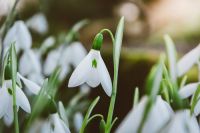
Enjoy a snowdrop day and learn to really appreciate the delicate beauty of Britain’s best-loved early spring flower. February is the best time to visit gardens which specialise in snowdrops, and many hold snowdrop days so you can marvel at hundreds of different varieties.
Among the best places to see snowdrops are the massive winter garden at Dunham Massey, in Cheshire, with thousands of snowdrops nestled among irises, daffodils and bluebells. Myddleton House in Enfield, Middlesex, is famous for its rare snowdrops, many collected by the plantsman EA Bowles; and at Cambo Estate in Scotland there are over 70 acres of woodland to explore planted with over 350 varieties of snowdrop.
Although many of us grow the common wild snowdrop, Galanthus nivalis, there are many different kinds to try. Some, like ‘Atkinsii’, are early to flower (Galanthus reginae-olgae is regularly in flower in autumn). Others, such as ‘S. Arnott’ bloom as late as March. There are single or double varieties; some have rounded petals, or particularly large flowers; others have pleated leaves, or blue-grey foliage. You can find curious markings on the petals from spots and splashes to green tips; and some snowdrops are coloured yellow rather than green.
You’ll find ready-planted baskets of snowdrops here at the garden centre in Hemlington and Middlesbrough to plant out straight in to your garden for an instant splash of spring cheer. Add to your collection with a few different varieties: ask our friendly garden centre staff to let you know what we have in stock. Once the flowering season is over, you can plant snowdrops ‘in the green’ – as clumps of in-leaf plants which establish more easily than bulbs. Give your new snowdrops a shady spot and light, well-drained soil – and remember to label them so you remember where your special varieties are planted next spring!

